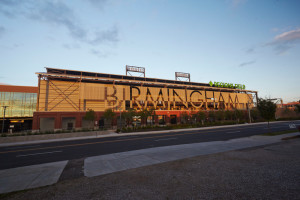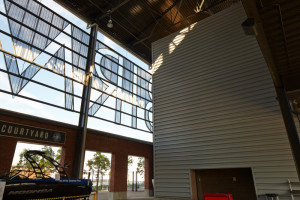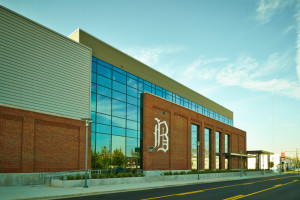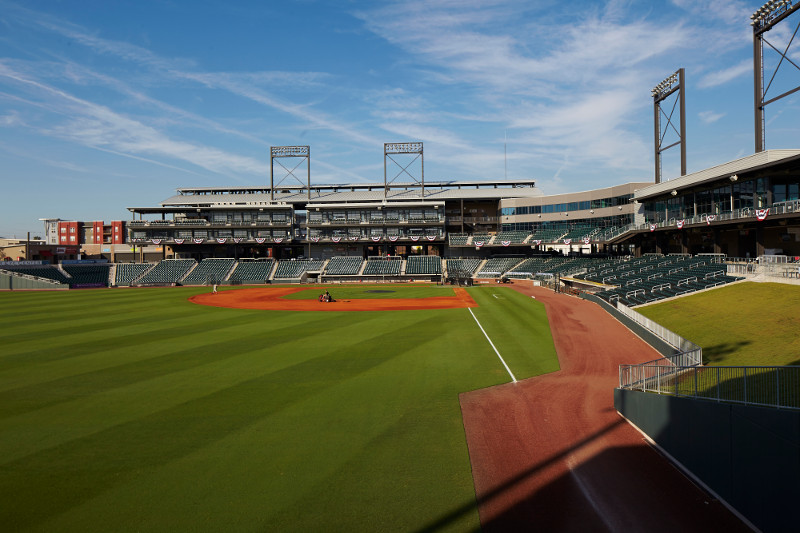
Regions Field’s custom metal façade is a statement of civic pride.
From the front office to the dugout, members of the Birmingham Barons Double-A baseball club will tell you their success is the result of a total team effort. The same is true for the dedicated professionals behind the club’s award-winning ballpark, Regions Field.
The aesthetic focal point of the ballpark is the city’s name, cut in towering letters with a unique, inside-out effect. The bold design, known as the “Birmingham façade,” has become one of the iconic images of the city. The Barons christened their new stadium on opening day in April, 2013 following just 14 months of construction.
Project designer Kevin Suter, LEED AP, with Dallas-based HKS Architects, decided early on in the design process to make a statement along the western façade, positioned just a few blocks from an elevated highway.
“We thought it was a perfect place to make a statement of civic pride—to announce the city and to encourage people to come back,” Suter noted.
Overcoming Obstacles
The city of Birmingham imposes strict ordinances and size restrictions on signage, based on the retail developments that dominate the area. But Suter and his team from HKS presented the Birmingham letters as a façade element all along, stressing the importance of controlling the amount of daylight that enters the western façade. Suter specified CENTRIA’s EcoScreen perforated screenwall to limit the area’s exposure to sunlight.
“One of our original objectives was to knock down the sun on that west wall,” Suter explained. “Behind that area is an open air concourse that is certainly a functional part of the ballpark.”
EcoScreen also created an unexpected aesthetic effect, drawing nothing but positive feedback from the Birmingham fan base.
“It ended up creating a really nice effect with the transition from day to night,” Suter said. “Where the façade looks solid and flush in the day, it lights up nicely and glows in the evening.”
Flexibility Leads to Innovation
The Birmingham façade is the result of a cumulative effort from all parties involved, beginning with CENTRIA’s experienced team of engineers, project managers, and plant personnel, who tailored a brand new design to fit the complex specifications. Chad Martin, Division Manager of installer FLC Systems, originally planned to outsource the task of letter cutting, before he had the opportunity to tour CENTRIA’s Frankfort, Ky. plant in late 2012 to review the company’s manufacturing capabilities.
T he Frankfort, Ky. plant incorporated water-jet technology, but CENTRIA had never used the technology for this type of application. Frankfort Plant Manager Gary Brunette and his team were charged with applying the facility’s cutting technology to the complicated Birmingham signage.
he Frankfort, Ky. plant incorporated water-jet technology, but CENTRIA had never used the technology for this type of application. Frankfort Plant Manager Gary Brunette and his team were charged with applying the facility’s cutting technology to the complicated Birmingham signage.
CENTRIA’s engineering and detailing services enabled a smooth process, even for this difficult, new application. They created CAD files—a total of 250 drawings for the individual panels—and material requirements.
The 36-inch wide panels were very intricate, requiring complicated fabrication. “The trick was the engineering work, drawings and designs, this allowed us to execute the cutting at our plant without any issues,” Brunette said.
“The most interesting thing about it was obviously the upper panels were cut to the outside parameters, while the lower panels were cut to the inside parameters, which gives it the effect that the architect was looking for,” Brunette said. “We created the panels one at a time, moving right down the line starting with the ‘B’ in Birmingham. We shipped them out in ten crates—one for each letter.”
No two panels were the same—even for repeated letters the pieces were cut from different areas of the panels. Due to the sharp edges created by the water-jet technology, each panel that made up each letter had to be handled and packaged carefully. The Frankfort plant created mark numbers for each panel, providing a detailed installation sequence and instructions for the FLC Systems team.
“That’s something that would usually be reserved for an insulated panel—never before for single-skin panels,” Brunette explained.
Perfect Timing
As Senior Project Manager Rick Miskanic explained, the approval process included a trip to the jobsite to review shop drawings, just one of many services offered by the CENTRIA Building Envelope Solutions (CBES) team. The architect agreed to a one-day approval process to keep things moving forward to meet the tight deadline.
Miskanic used his field construction knowledge and the resources of CENTRIA’s Design & Development group to work around a span issue, committing to a complete product shipment by March 18, leaving FLC Systems adequate time to install the panels before opening day. From detailing to procurement, painting, shop production and delivery—CENTRIA had only four months to complete their work for the project.
“CENTRIA was able to step up and produce the letters within our time frame,” Suter said.
Not only were the panels fabricated at a record pace, they were also installed at the jobsite without a hitch, according to Martin. A veteran installer of CENTRIA’s single-skin metal panels, Martin labeled Regions Field as one of his “all-time favorite projects,” noting the build team’s ability to produce a stunning project under tight time constraints.
“The letter cutting was exceptional,” Martin said. “I think we provided a very unique look for this stadium, and I am guessing that this will be copied again very soon. It gives me a great sense of pride knowing I was part of such an innovative use of CENTRIA products.”
CENTRIA’s dedicated and experienced dealer network allows them to take on complicated jobs like this one, and know that their product will be installed properly, by expert installers like Martin and his team. For this project, the fabricator also had to supply the support system necessary to protect the intricate panels.
A Design Home Run
Besides the celebrated Birmingham façade, other design goals for Regions Field revolved around the city’s industrial heritage “as the manufacturing center of the South,” Suter said. Reflecting the design of some of the historical brick, ironwork, and steel buildings in the area, Suter showcased CENTRIA’s metal panels, creating a familiar form with all the modern amenities of a state-of-the-art ballpark. All told, Regions Field utilizes over 50,000 square feet of CENTRIA single-skin metal panels, encompassing a large portion of the ballpark’s mixed-medium exterior.
New Opportunities
Before this project, the typical EcoScreen panel use was not highly aesthetic. This project opened up not only CENTRIA’s water-jet cutting capabilities, but also the applications of the EcoScreen panel.
“Since this project we’ve had many requests for very aesthetic and unique applications of EcoScreen. It launched a new use for the product,” Miskanic said.
With their experienced engineering, design and development teams, CENTRIA prides itself in pushing the envelope with its products and their applications. And with district sales managers across the country, CENTRIA develops relationships with architectural firms and provides their expertise and support for a range of projects.
The Birmingham Barons capped off the inaugural season in their new ballpark with a championship, just a month after Regions Field was crowned Ballpark of the Year by Baseballparks.com.


